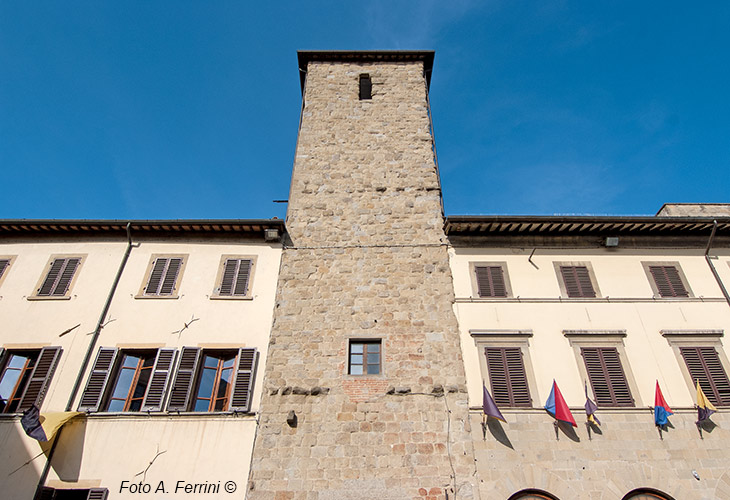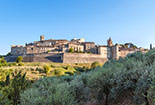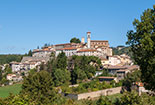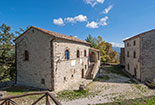SANSEPOLCRO
in Valtiberina, the land of Piero Della Francesca, the first bathed by the Tiber

Texts and photos by Alessandro Ferrini ©
30 accurately described images of Sansepolcro. Click to enlarge
Sansepolcro, a place of art with a very ancient history
 Sansepolcro is the largest town in the Tuscan Valtiberina. It is located along the E45 highway that connects Romagna with Umbria. It can also be quickly reached from Anghiari via eight kilometers of completely straight road.
The Resurrection, a fresco painted around 1460 by Piero Della Francesca, alone justifies a visit to the town located a short distance from the Tiber. Around this extraordinary work painted in a historic building a stone's throw from the Duomo and the Palazzo Comunale, an important museum has been created where, in addition to other paintings by the great Master born in this place around 1416 (a Madonna della Misericordia and two fragments of detached frescoes showing San Giuliano and San Ludovico), an artistic heritage of considerable value is preserved.
The origins of this village date back to the 10th century when two pilgrims returning from the Holy Land founded a Benedictine abbey here dedicated to the Holy Sepulcher, hence the name of the town. Around the middle of the 12th century, this monastic congregation passed under the Camaldolese Order. It was in this period that the urban development of Sansepolcro began, which in the mid-fourteenth century had already reached the size of the town today inside the walls. The establishment of an important weekly market which brought together people from most of this land along the Tiber influenced this great and rapid growth. This development was largely canceled out by a devastating earthquake of 1352.
Sansepolcro is the largest town in the Tuscan Valtiberina. It is located along the E45 highway that connects Romagna with Umbria. It can also be quickly reached from Anghiari via eight kilometers of completely straight road.
The Resurrection, a fresco painted around 1460 by Piero Della Francesca, alone justifies a visit to the town located a short distance from the Tiber. Around this extraordinary work painted in a historic building a stone's throw from the Duomo and the Palazzo Comunale, an important museum has been created where, in addition to other paintings by the great Master born in this place around 1416 (a Madonna della Misericordia and two fragments of detached frescoes showing San Giuliano and San Ludovico), an artistic heritage of considerable value is preserved.
The origins of this village date back to the 10th century when two pilgrims returning from the Holy Land founded a Benedictine abbey here dedicated to the Holy Sepulcher, hence the name of the town. Around the middle of the 12th century, this monastic congregation passed under the Camaldolese Order. It was in this period that the urban development of Sansepolcro began, which in the mid-fourteenth century had already reached the size of the town today inside the walls. The establishment of an important weekly market which brought together people from most of this land along the Tiber influenced this great and rapid growth. This development was largely canceled out by a devastating earthquake of 1352. Sansepolcro stopped for almost a century, only after 1440, the year in which with the Battle of Anghiari Florence affirmed its dominion over this Tuscan territory, there was a restart. The walls were strengthened and at the beginning of the sixteenth century the fortress was rebuilt on a project by Giuliano da Sangallo who went to enlarge a pre-existing fourteenth-century fortress built by the Malatesta of Rimini, at that time lords of the place. A few decades later, with the Grand Duke Cosimo I De 'Medici, Sansepolcro acquired that architectural aspect that today we can largely observe in its historic center characterized by many elegant Renaissance palaces. The “heart” of Sansepolcro is the large and elegant Piazza Torre di Berta. This was the name of a thirteenth-century tower located in the center of this urban space. The tower was blown up in 1944 by retreating German troops.
In addition to the civic museum mentioned, Sansepolcro has other places of art: they are the different churches present. The most important, for its architecture and the art that is preserved there, is the Cathedral dedicated to St. John the Evangelist. This, in the first half of the fourteenth century, replaced the abbey that had given rise to the place. Given the period of construction, the Cathedral has a Romanesque Gothic style. On the façade there is a large rose window, the interior has three naves divided by mighty columns. Of particular value is the art preserved here.
Sansepolcro stopped for almost a century, only after 1440, the year in which with the Battle of Anghiari Florence affirmed its dominion over this Tuscan territory, there was a restart. The walls were strengthened and at the beginning of the sixteenth century the fortress was rebuilt on a project by Giuliano da Sangallo who went to enlarge a pre-existing fourteenth-century fortress built by the Malatesta of Rimini, at that time lords of the place. A few decades later, with the Grand Duke Cosimo I De 'Medici, Sansepolcro acquired that architectural aspect that today we can largely observe in its historic center characterized by many elegant Renaissance palaces. The “heart” of Sansepolcro is the large and elegant Piazza Torre di Berta. This was the name of a thirteenth-century tower located in the center of this urban space. The tower was blown up in 1944 by retreating German troops.
In addition to the civic museum mentioned, Sansepolcro has other places of art: they are the different churches present. The most important, for its architecture and the art that is preserved there, is the Cathedral dedicated to St. John the Evangelist. This, in the first half of the fourteenth century, replaced the abbey that had given rise to the place. Given the period of construction, the Cathedral has a Romanesque Gothic style. On the façade there is a large rose window, the interior has three naves divided by mighty columns. Of particular value is the art preserved here. We find works ranging from the fourteenth to the seventeenth century by artists such as Bartolomeo Della Gatta, who was inspired by the painting of Piero Della Francesca, Santi di Tito, local painter, Durante Alberti. Behind the main altar is an extraordinary fourteenth-century work: the Polyptych of the Resurrection by the Sienese painter Niccolò di Segna. Then there is another 16th century Resurrection by Raffaellino del Colle. The Holy Face is preserved in the Cathedral, a painted wooden crucifix of high devotional value for the inhabitants of Sansepolcro. Dating from the 9th century, it is probably the work of this kind known to date.
Other churches to visit are that of San Francesco, San Rocco, Santa Maria dei Servi, Santa Maria della Grazia, Sant’Agostino and that of San Lorenzo where there is a sixteenth-century panel by Rosso Fiorentino showing the Deposition.
Very interesting to visit is the Aboca Museum, an exhibition created by the important company specializing in the cultivation and transformation of medicinal plants.
We find works ranging from the fourteenth to the seventeenth century by artists such as Bartolomeo Della Gatta, who was inspired by the painting of Piero Della Francesca, Santi di Tito, local painter, Durante Alberti. Behind the main altar is an extraordinary fourteenth-century work: the Polyptych of the Resurrection by the Sienese painter Niccolò di Segna. Then there is another 16th century Resurrection by Raffaellino del Colle. The Holy Face is preserved in the Cathedral, a painted wooden crucifix of high devotional value for the inhabitants of Sansepolcro. Dating from the 9th century, it is probably the work of this kind known to date.
Other churches to visit are that of San Francesco, San Rocco, Santa Maria dei Servi, Santa Maria della Grazia, Sant’Agostino and that of San Lorenzo where there is a sixteenth-century panel by Rosso Fiorentino showing the Deposition.
Very interesting to visit is the Aboca Museum, an exhibition created by the important company specializing in the cultivation and transformation of medicinal plants.








































